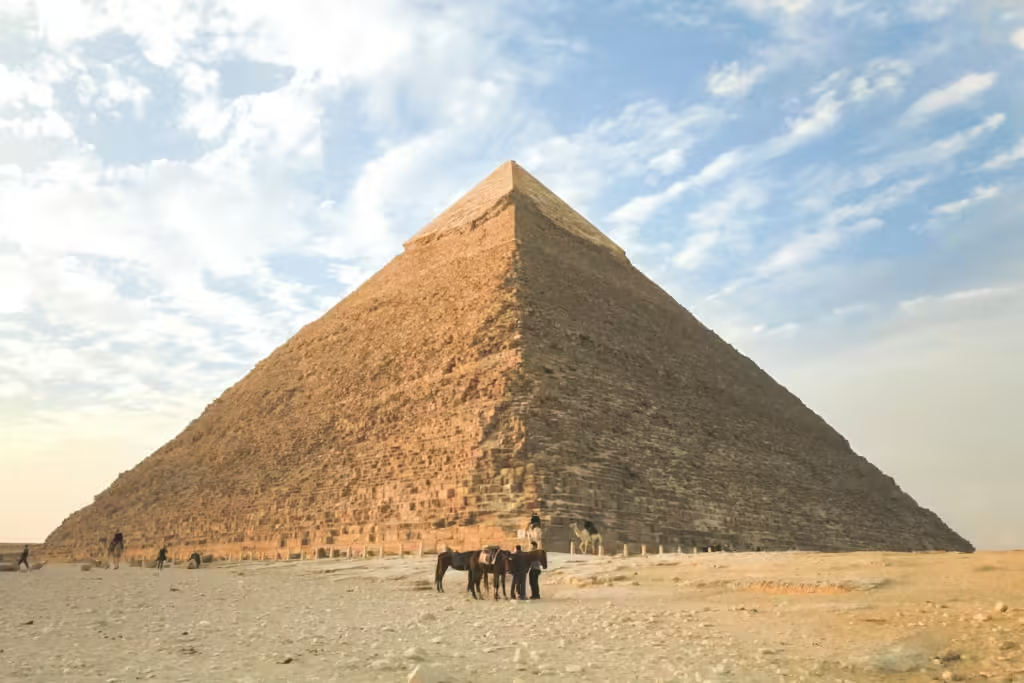Table of Contents
The purpose of the hidden chamber that archaeologists discovered at the foot of the Great Pyramid of Giza remains unknown.
Archaeologists may have uncovered a new mystery beneath the sands of the Western Cemetery in Giza, one of the numerous mysteries of Egypt’s ancient history.
Hundreds of rectangular tombs known as mastabas, which border the base of Giza’s Great Pyramid, are housed in the Western Cemetery. These mastabas are owned by affluent individuals and are related to the approximately 4,500-year-old Ancient Egyptian monarch Khufu.
Nevertheless, one section of the cemetery is empty, devoid of any buildings, in sharp contrast to the numerous rows of tombs. It’s a different narrative beneath the sand, archaeologists have recently found.
Perhaps hidden beneath what looks like a flat, sandy surface are long-lost structures dating back thousands of years. What looks to be an L-shaped building is only a few feet below the surface. There’s another, bigger structure attached to the original one, even deeper.
The researcher Motoyuki Sato, who assisted in identifying the oddity, told Live Science that the L-shaped structure’s corners are “too sharp” to be found in nature.
The researchers noted in an article they just published in the peer-reviewed journal Archaeological Prospection that this shows humans constructed it and would explain why such a big swath of the dense necropolis remains empty above the sand.
Both features may represent the remains of an old tomb, the experts speculate. Still, there are still a lot of unsolved questions following the finding.
Radar and other high-tech technologies are used in archeology to uncover hidden mysteries.

It required years of meticulous excavation in the early days of archeology to determine the size and geometry of a structure. Without even disturbing a shovel’s worth of dirt, experts may now map previously undiscovered buildings with the use of more advanced tools.
That’s how this most recent obscure bit of history was discovered by researchers from Higashi Nippon International University, Tohoku University, and the National Research Institute of Astronomy and Geophysics in Egypt.
The region was investigated by the researchers between 2021 and 2023 utilizing two cutting-edge techniques: electrical resistivity tomography (ERT) and ground-penetrating radar (GPR). GPR maps shallow subterranean features with great resolution by using electromagnetic waves. Although not as precisely, ERT can find walls, shafts, and other similar anomalies in deeper structures.
The researchers used a combination of satellite, ERT, and GPR data to find an L-shaped structure buried 1.6 to 6.5 feet below the surface of the sand. The structure measured about 32 by 50 feet. Beyond the L-shaped anomaly, they also discovered indications of a 1,000-square-foot structure located between 11.5 and 33 feet below the surface.
Excavation is the next step.
The shallower L-shaped structure was formerly filled with sand, which may provide insight into its intended use. The experts surmised that it might have functioned as a sort of gateway to a subterranean tomb. Such tunnels were frequently sealed by the ancient Egyptians to keep the living out.
Archaeologists can only get so far with GPR and ERT, despite the fact that these methods can provide a more comprehensive picture of subsurface archaeological findings.
The data from the two methods did not quite match, and the researchers observed that the methodologies occasionally inflate anomalies.
There are still more riddles to solve. They have no idea what might be hidden in the deeper structure, if anything. It could be completely empty or loaded with sand.
In order to address several of these inquiries, the archaeologists had to practically begin excavating.
read also: Scientists claim to have discovered a way to reverse the aging process 2024.
Pyramid of Giza Pyramid of Giza Pyramid of Giza Pyramid of Giza Pyramid of Giza


1 thought on “The purpose of the hidden chamber that archaeologists discovered at the foot of the Great Pyramid of Giza remains unknown.”